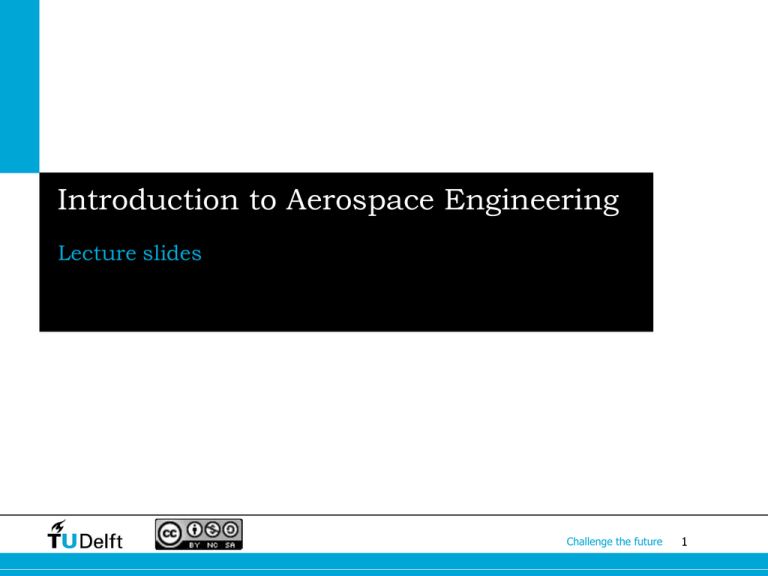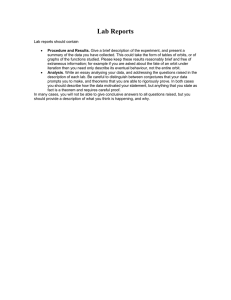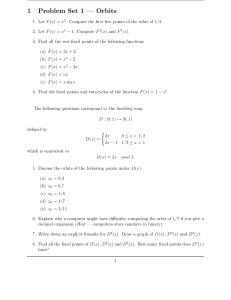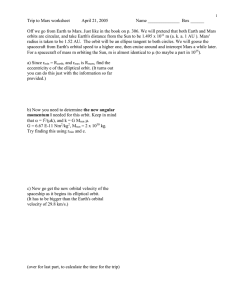Introduction to Aerospace Engineering
advertisement

Introduction to Aerospace Engineering Lecture slides Challenge the future 1 Part of the lecture material for this chapter originates from B.A.C. Ambrosius, R.J. Hamann, R. Scharroo, P.N.A.M. Visser and K.F. Wakker. References to “”Introduction to Flight” by J.D. Anderson will be given in footnotes where relevant. This topic is (to a large extent) covered by Chapter 8 of “Introduction to Flight” by Anderson. 3 Anderson’s “Introduction to Flight” (at least the chapters on orbital mechanics) is NOT part of the material to be studied for the exam; it is “just” reference material, for further reading. The inclination “i” is the angle between the orbital plane and a reference plane, such as the equatorial plane. It is measured at the ascending node, i.e. the location where the satellite transits from the Southern Hemisphere to the Northern Hemisphere, so by definition its value is between 0° and 180°. The parameters Ω and ω can take any value between 0° and 360°. 8 This is an illustration of a most general maneuver: both in-plane and cross-plane. Important: we assume that maneuvers take effect instantaneously, i.e. a ∆V is achieved in an infinitesimal small time-step: the so-called impulsive shot. Here, ∆i is the angle between Vi and Vf . The best strategies for the first 3 cases are based on the equation on the previous page, whereas the 4th conclusion follows from elementary mathematics for triangles. µEarth = 398600.44 km3/s2; REarth = 6378.137 km µEarth = 398600.44 km3/s2; REarth = 6378.137 km sin(∆i/2) = (∆V/2)/V. Answers (DID YOU TRY FIRST?): 1. ∆V = 2.460 km/s 2. ∆V = 1.581 km/s 3. ∆V = 5.214 km/s Answers (DID YOU TRY FIRST?): 4. ∆V = 2.460 km/s 5. ∆V = 0.225 km/s 6. ∆V = 1.845 km/s 7. ∆V = 0.390 km/s 8. identical. Interpretation? Notice the order of activities: (1) apocenter-raising maneuver, (2) series of pericenter-raising maneuvers, and (3) the deployment of the solar panels. In principle, all options are possible. But: what is efficient in energy? In this arbitrary case, the transfer orbit intersects the initial orbit (orbit 1) and the target orbit (orbit 2). 18 19 20 µEarth = 398600.44 km3/s2; REarth = 6378.137 km Answers (DID YOU TRY FIRST?): 1. ∆V = 0.096 km/s 2. ∆V = 0.491 km/s 3. ∆V = 0.587 km/s 4. ∆V1+∆V2=∆V3 5. ∆V = 0.159 km/s Compare the dimension of the Sphere of Influence (SoI) with an Astronomical Unit: -> satellite will spend far majority of flight time in heliocentric phase. Patched comics approach is good to distinguish between “local” (i.e. around planets) and “global” (i.e. around Sun) phases of flight, and get 1st-order solutions for the satellite motions (using relations for standard Kepler orbits). The same transfer problem, but now on the scale of the solar system. This table gives some relevant data on the orbits of the planets. As with Hohmann transfers between orbits around the Earth, a Hohmann transfer between orbits (here: between two celestial bodies) is a minimum-energy transfer. Its apocenter and pericenter are tangential to the departure and arrival orbits, and it covers 180° in true anomaly. 28 The semi-major axis is the average of the pericenter radius and the apocenter radius. The velocities in pericenter and apocenter are computed with the standard visviva equation for the velocity in an orbit: ½ V2 – µ/r = - µ/(2a). The velocities for Earth and Mars itself are circular velocities. The excess velocities V∞ are the (absolute) difference between the velocity in the ellipse and the corresponding circular velocity of the relevant celestial body. So: heliocentric velocity must be increased at Earth by 2.95 km/s, in order to “take the wider swing to Mars”, and be lowered at Mars by 2.65 km/s in order to catch up with the circular velocity of Mars itself. Answers: (DID YOU TRY??) 1. a = 3.1 AU = 463.8 × 106 km 2. e = 0.677 3. Vp = 38.575 km/s 4. Va = 7.418 km/s 5. T = 86137877 s = 997 days = 2.73 yrs Answers: (DID YOU TRY??) 1. VEarth = 29.784 km/s 2. a = 1.197 × 109 km = 8.00 AU 3. e = 0.875 4. θ = 0° 5. θ = 136.95° 6. T = 40618428 s = 470.12 days = 1.29 yrs The MER “Spirit” was launched on June 10, 2003, for a Martian roving mission planned to take 90 sols (i.e. 90 Martian days, 24h 37m 22s each). It is accompanied by a twin rover “Opportunity”. Both are still operating in Summer 2009. The orbit from Earth to Mars flown by “Spirit” is a so-called type-I orbit: shorter (faster) than a minimum-energy Hohmann orbit. The MErcury Surface, Space ENvironment, GEochemistry, and Ranging (MESSENGER) mission, launched on August 3, 2004. The Indian Moon-mission Charndrayaan-1, launched on October 22, 2008. 35 36



